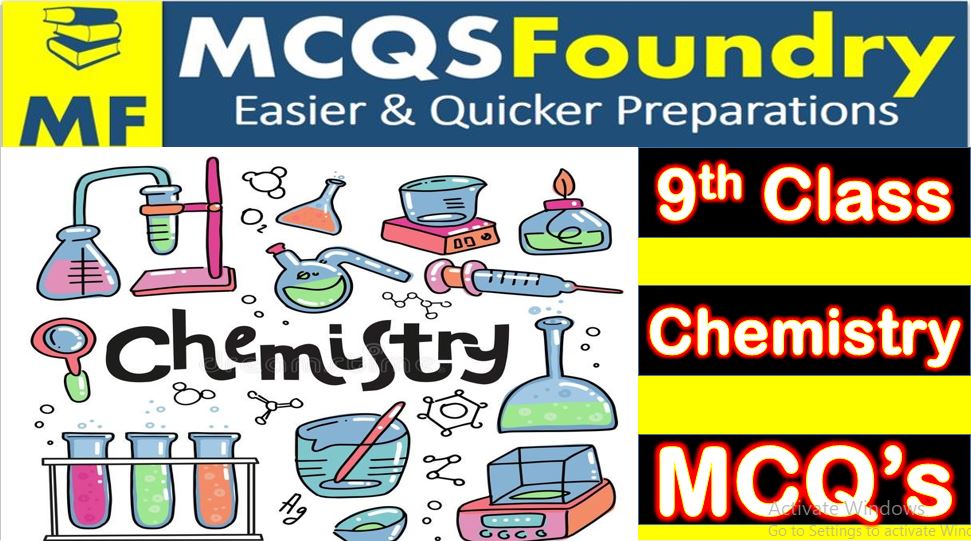MCQsFoundry.com brings to you 500+ 9th Standard Chemistry Mcqs which are new and latest. These Mcqs are never published on internet so far. For full information about all PPSC / FPSC / CSS / PMS latest jobs visit theiteducation.com

| 01 | 9th Class Chemistry Mcqs Chapter 01 | 02 | 9th Class Chemistry Mcqs Chapter 02 |
| 03 | 9th Class Chemistry Mcqs Chapter 03 | 04 | 9th Class Chemistry Mcqs Chapter 04 |
| 05 | 9th Class Chemistry Mcqs Chapter 05 | 06 | 9th Class Chemistry Mcqs Chapter 06 |
| 07 | 9th Class Chemistry Mcqs Chapter 07 | 08 | 9th Class Chemistry Mcqs Chapter 08 |
| 09 | 9th Class Chemistry Mcqs Chapter 09 | 10 | 9th Class Chemistry Mcqs Chapter 10 |
| 11 | 9th Class Chemistry Mcqs Chapter 11 | 12 | 9th Class Chemistry Mcqs Chapter 12 |
CHAPTER NO 5
Physical States of Matter
Encircle the most appropriate answer among the following options
1 Which among the following expand or compressed easily
(a) Liquid
(b) Gases
(c) Solids
(d) Water
2 Diffusion is faster in:
(a) Liquid
(b) Solids
(c) Gases
(d) Plasma
3 Gases exerts pressure in all directions
(a) Uniformly
(b) Randomly
(c) Alternately
(d) Constantly
4 Which principle is applicable in a working pressure cooker?
(a) Boiling point will be more by increasing the external pressure
(b) Boiling point will be less by decreasing the external pressure
(c) Boiling point will be more by increasing the external pressure
(d) None of these
5 Red phosphorus is:
(a) Less reactive
(b) Non-poisonous
(c) Brittle
(d) All of above
6 Which of the following percentage of salt is required to kill the bacteria?
(a) 10%
(b) 20%
(c) 30%
(d) 40%
7 The density of gold is:
(a) 2.70 gcm3
(b) 7.86 gcm3
(c) 9.3 gcm3
(d) 2.98 gcm3
8 The solids in which particles are arranged in definite three-dimensional pattern are known as:
(a) Solids
(b) Crystalline solids
(c) Amorphous solids
(d) both ‘B’ and ‘C’
9 The transition temperature of tin is:
(a) 96°C
(b) 250°C
(c) 18°C
(d) 100°C
10 Oxygen has two allotropic forms:
(a) O2 and O4
(b) O2 and O3
(c) O and O3
(d) O2 and O
11 Plastics, glass rubber, lamp-black etc. are the examples of:
(a) Crystalline solids
(b) Super cooled liquids
(c) Amorphous solids
(d) Ionic solids
12 The temperature at which the solid and liquid phases of a substance co-exist is known as :
(a) Freezing point
(b) Boiling point
(c) Melting point
(d) Equilibrium
13 The presence of solid in different physical forms is known as:
(a) Crystals
(b) Allotropy
(c) Evaporation
(d) Transition
14 Among the following which depends upon the nature of liquid, intermolecular forces and external pressure.
(a) Melting point
(b) Freezing point
(c) Boiling point
(d) None of these
15 The conversion of a liquid into vapours at all temperature is known as .
(a) Evaporation
(b) Boiling
(c) Cooling process
(d) Both ‘A’ and ‘C’
16 Density is expressed in:
(a) g cm3
(b) g dm3
(c) Both ‘A’ and ‘B’
(d) None of these
17 Charles described, how gases tend to expand when heated:
(a) 1882
(b) 1802
(c) 1820
(d) 1828
18 Mass per unit volume is called:
(a) Pressure
(b) Temperature
(c) Density
(d) Solubility
19 Robert Boyle’s was a natural:
(a) Philosopher
(b) Chemist
(c) Physicist
(d) All of above
20 Matter exists in three physical states:
(a) Solid, liquid, plasma
(b) Solid, water, vapour
(c) Plasma, liquid, solid
(d) Solid, liquid, gas
21 Which one of the following gases diffuse most slowly?
(a) O2
(b) Cl2
(c) NH3
(d) H2
22 Pascal is the SI unit of:
(a) Force
(b) Volume
(c) Momentum
(d) Pressure
23 At 0°C the density of O2 gas is:
(a) 1.5g dm3
(b)1.4g dm3
(c) 4.1g dm3
(d) 0.15g dm-3
24 V/T=K is the mathematical form of:
(a) Boyle’s law
(b) Charles law
(c) Avogendo law
(d) Dalton law
25 -273°C after conversion to Kelvin scale becomes:
(a) OK
(b) 273K
(c) 173K
(d) 100K
26 At which temperature rate of evaporation of water is minimum?
(a) 50°C
(b) 40°C
(c) 90°C
(d) 70.5°C
27 The molecular formula of decane is
(a) C6H14
(b) C7H16
(c) CaH20
(d) C10H22
28 C6H14 is the molecular formula of
(a) Pentane
(b) Hexane
(c) Propane
(d) Decane
29 At a given temperature which of the following has maximum vapour pressure
(a) C5H12
(b) C6H14
(c) C3H10
(d) C8H18
30 The density of gold is:
(a) 270 gcm
(b) 7.869 cm3
(c) 19.3g cm
(d) 1.4g cm
31 250°C is the transition temperature of which substance:
(a) Tin
(b) Carbon
(c) Phosphorus
(d) Sulphur
32 The crystal structure of which tin is
(a) cubic
(b) tetragonal
(c) monoclinic
(d) None of these
33 Freezing point of acetic acid is:
(a) -116°C
(b) 16.6°C
(c) -56°C
(d) -115°C
34 The vapour pressure of which liquid is 200mm Hg at 0°C?
(a) Water
(b) Alcohol
(c) Honey
(d) Ether
35 2×101325 Pa is equal to
(a) 1.56 atm
(b) 2.0 atm
(c) 15.8 atm
(d) 8.15 atm
36 Normal body temperature is
(a) 98.6°F
(b) 37°C
(c) Both a and b
(d) 98.6°C
37 The freezing point of n-octane is
(a) -57°C
(b) 126°C
(c) 34.6°C
(d)-116°C
38 760 mmHg is equal to
(a) 266 torr
(b) 2660 torr
(c) 626 torr
(d) 1 atm
39 1 atm has how many pascals?
(a) 151987.5 Pa
(b) 19187.5 Pa
(c) 9187.6 Pa
(d) 101325Pa
40 In which unit density of gases is measures?
(a) kg mm-3
(b) cm-3
(c) gdm-3
(d) gcm-3
